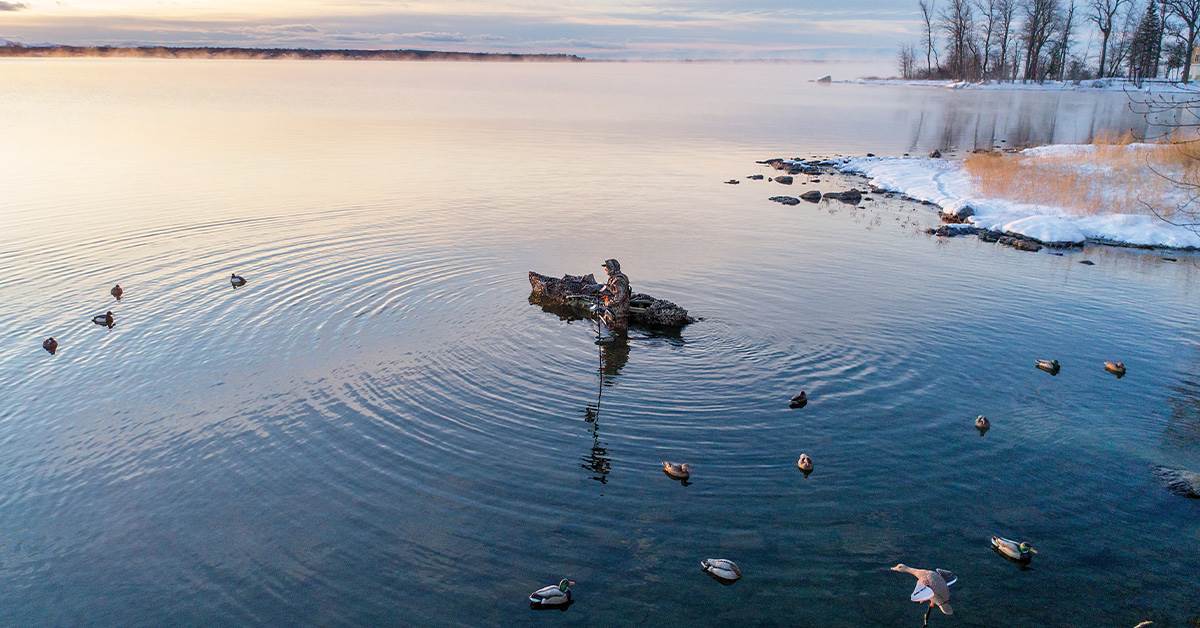The Other Duck Boat
Today’s kayaks offer waterfowlers an inexpensive and versatile way to access even the most out-of- the-way hunting spots
Today’s kayaks offer waterfowlers an inexpensive and versatile way to access even the most out-of- the-way hunting spots

By Bill Buckley

Kayaks are not only sleek and easy to paddle but also carry a surprising amount of gear.
In case you haven't noticed, fishing kayaks have become wildly popular among waterfowlers in recent years. For those of us who either can't afford a traditional duck boat or are simply looking for greater mobility while hunting shallow-water habitats, these versatile craft are a tremendous boon. Depending on what type of kayak you are looking for, suitable models are available at prices ranging from as little as $300 to in excess of $5,000.
Sit-on-top kayaks are generally more comfortable, easier to shoot from because the seat is higher off the water, and have more accessible storage space than sit-in models. Most sit-on-tops are also designed with a wide, pontoon-shaped hull that offers greater stability, which is a huge plus for hunting in cold weather. Conversely, the more tapered hulls of sit-in models are lighter, easier to paddle, and protect you from the elements better because much of your lower body is enclosed inside the hull.
Like everything in life, there are tradeoffs. What you gain in stability and storage with a sit-on-top kayak, you pay for in increased weight and less portability. Still, most duck hunters will want a sit-on-top.
What about length? A 12- to 13-foot kayak will fit most hunters' needs and offer enough storage capacity to carry a decoy bag, gun, dog, camouflage, and other gear. A long kayak will track better while paddling than a short one. If you want your kayak to double as a layout blind, a 10-foot model will likely be too short, but a lot depends on how the deck is molded.
Your next decision is whether to buy a pedal-drive kayak or stick with a paddle for propulsion. Pedal drives are convenient for covering greater distances, and they can be powered with both hands free. The downside is they are significantly more expensive.
Garrick Dixon, who spends over 40 days a year hunting waterfowl on Vermont's Lake Champlain, has hunted out of Native Watercraft kayaks for years. He sums up why so many waterfowlers have recently begun hunting from these solo watercraft. "I love the simplicity and convenience. They're easy to store, I don't have to worry about a boat motor breaking down or a boat ramp being iced over, and I can go anywhere I want," he says. "I simply slide my kayak into the bed of my truck, throw a few bags of decoys on top, and head out. They're also easy to hide and tough enough to drag across ice, or break through it, when necessary."
While his widest kayak can accommodate more than 60 decoys, Dixon sometimes uses a Jet Sled to tow two more bags of duck decoys or goose floaters. While hunting from his kayak in deeper water, he anchors each end of the boat to keep it from swaying in the wind. He attaches the end of each anchor line to a decoy and uses a quick-release, long-line clip to secure the kayak to the line so he doesn't have to pull up anchors every time he retrieves a bird.
Ghillie blankets and camo netting are great for hiding kayaks, and Dixon leaves his fishing-rod holders positioned on either side of his seat to support camo netting and brush that he cuts on-site to fashion a quick blind-perfect for setting up along a shoreline. Open-water hunters might find custom covers, either from the manufacturer or boatcoversdirect.com, a great option for concealment in open water and added protection from the elements.
Alway wear a PFD. "As much as I trust my kayaks, accidents can happen quickly," Dixon says. "Don't forget to pack a dry bag with an extra set of warm clothes." Also be sure to wear a tight-fitting wader belt.
Sit-on-top kayaks tend to accumulate water. Bringing along a large sponge for mop-ups will help keep you drier and warmer throughout the hunt.
Dixon also recommends using a floating gun case that's strapped to the boat, and always tethering your paddle to yourself or your kayak.
Ducks Unlimited uses cookies to enhance your browsing experience, optimize site functionality, analyze traffic, and deliver personalized advertising through third parties. By continuing to use this site, you agree to our use of cookies. View Privacy Policy